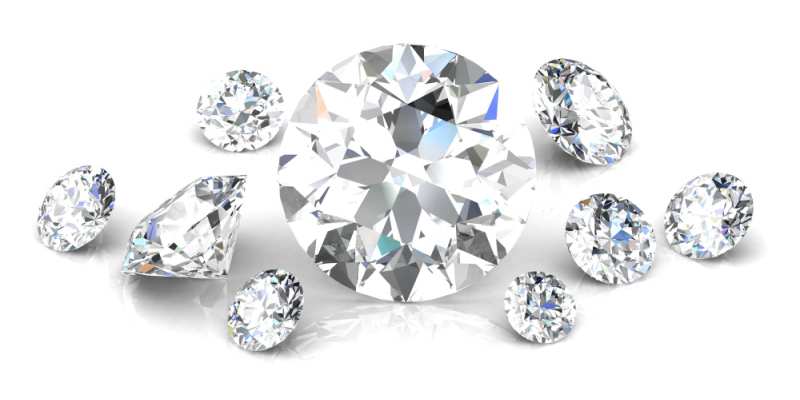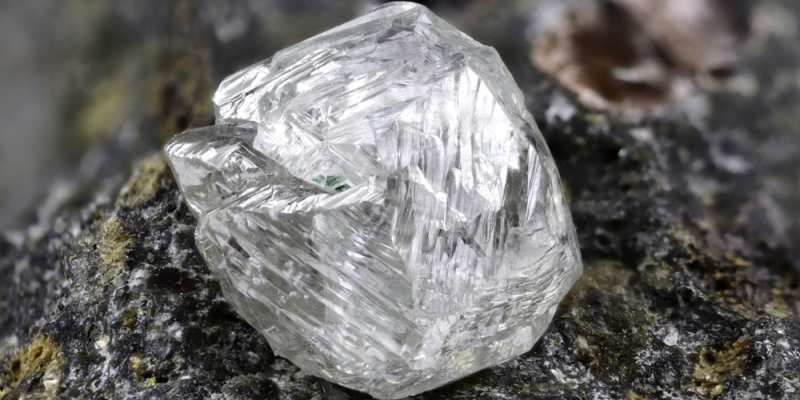Not all that glitters has to be gold, or in this case, a diamond, to make a special occasion shine. When you think of purchasing jewelry, diamonds are often the first gemstones that come to mind. However, if you have high expectations for size, you might find yourself disappointed by the astronomical prices. Luckily, there are plenty of sparkling alternatives that can satisfy your desires without breaking the bank. One such option is the white topaz.
Now you might be wondering, what exactly is a white topaz? It is a clear and translucent gemstone that is widely regarded as a diamond alternative. Before we delve into the ultimate choice and settle the white topaz versus diamond debate, let’s take a closer look at each of them.
Let’s dive right in!
DESIGN YOUR OWN ENGAGEMENT RING: START WITH A SETTING OR START WITH A DIAMOND. IT’S REALLY UP TO YOU!

What Is White Topaz?
Topaz is a natural gemstone that derives its name from its origin on an island called Topazion, now known as Zeberged, located in the Red Sea. However, there is an alternative theory on the origin of the name “topaz” that suggests it comes from the Greek word meaning “to seek.”
In ancient times, miners in the Urals referred to topaz as “heavyweight” due to its small size but high specific gravity compared to other gemstones. Topaz is renowned for its wide range of colors and shades, which depend on the geographic location of the deposit and the specific chemical composition of each specimen.
Among the various colors of topaz, white topaz is one of the most common and purest forms. In the past, it was believed to possess medicinal and magical properties. However, white topaz has other remarkable qualities as well.
This gemstone forms when water from surrounding rocks crystallizes magma, creating a rock called pegmatite, which can be found within dormant volcanoes. Topaz is found within this rock and becomes colorless when exposed to sunlight.
Isn’t it fascinating?

Attention: Easy To Confuse With A Diamond!
White topaz is often considered an affordable alternative to diamonds, despite being a relatively common gemstone. It shares similarities with diamonds, such as clear edges and high transparency, and exhibits rich color tones in its inner parts. These characteristics have given rise to various names for this gemstone, including “colorless topaz” and “white stone,” which can be confusing for those unfamiliar with gemstones.
However, there are certain aspects that differentiate white topaz from diamonds. As mentioned earlier, white topaz becomes colorless when it is near the surface during extraction and gradually loses any color shades when exposed to sunlight. This can make it difficult to distinguish between a white topaz and a diamond, especially after they have been cut and polished by a professional or someone attempting to sell a diamond imitation at a higher price. However, this is a simplified view of the matter.
Diamonds possess distinct characteristics that set them apart from other gemstones, including topaz. Diamonds are renowned for their exceptional hardness, which is unmatched by topaz. Additionally, diamonds exhibit superior optical properties compared to topaz.
Therefore, upon close examination, it is possible to differentiate diamonds from other gemstones, including white topaz.

White Topaz Vs. Diamond: Which One’s The One For You?
Diamond Vs. White Topaz: Origins
Diamonds are primarily produced in Botswana, Russia, Canada, and also in Australia and other African countries. In contrast, white topaz mainly comes from deposits in Brazil, Nigeria, and Sri Lanka. It can also be found in the United States, particularly in states like Texas and Utah.
Diamond Vs. White Topaz: Durability
Gemstone hardness is measured on the Mohs scale, ranging from 1 to 10. Diamonds have an impressive ranking of 10, making them the hardest natural mineral. White topaz, on the other hand, has a hardness rating close to 8, making it one of the hardest natural silicate minerals and harder than most gems.
Diamonds are scratch-resistant, while white topaz is not as hard and can potentially crack with a strong impact. Although white topaz does not match the hardness of diamonds, it still performs well in terms of durability compared to many other gemstones.
Diamond Vs. White Topaz: Clarity
Clarity refers to the degree of transparency and presence of inclusions in a gemstone. Gemstones with fewer internal inclusions are more valuable. Both diamonds and white topaz can contain internal inclusions, but smaller inclusions may not be visible to the naked eye. Both stones are popular choices due to their clarity, and it ultimately comes down to personal preferences.
Diamond Vs. White Topaz: Color
Both diamonds and white topaz are colorless in their purest form. However, white topaz can contain minor impurities that influence its color quality. If you’re seeking a white topaz that closely resembles a diamond’s colorlessness, you should opt for a perfectly colorless white topaz.
Diamond Vs. White Topaz: Cut
The cut of a gemstone, which includes factors like facet symmetry and angle measurements, determines how much light the gem reflects. Both diamonds and white topaz can be found in various cuts, but the most favored cut, particularly for a diamond imitation, is a round white topaz cut. The reflective index, which measures brilliance, may differ slightly between a round cut diamond and a round cut white topaz.
Diamond Vs. White Topaz: Sparkle
Diamonds outshine white topaz when it comes to sparkle. Diamonds exhibit exceptional brilliance and are known for their ability to reflect light. While white topaz can appear radiant and gorgeous under perfect lighting conditions, it is not as scratch-resistant as diamonds. Over time, scratches can accumulate on white topaz, leading to a cloudy and faded appearance. Diamonds may lose their sparkle due to accumulated dirt and oil on the surface, but a simple cleaning can restore their brilliance.
Diamond Vs. White Topaz: Size
Diamond size is generally less significant, as larger diamonds are rarer and more valuable. In contrast, smaller white topaz stones often have fewer imperfections and are priced higher. Additionally, the durability issues of white topaz, such as scratching and diminished brilliance, may be more noticeable with larger stones.
Diamond Vs. White Topaz: Value And Price
Diamonds hold significantly higher value and price compared to white topaz. Diamonds can cost thousands of dollars for a one-carat stone, while white topaz stones may range in the hundreds. However, white topaz can be a suitable option for those seeking an affordable alternative to diamond jewelry.
Diamond Vs. White Topaz: Maintenance
Diamonds require relatively low maintenance to keep them shiny. Cleaning with a soft brush and warm soapy water can remove dirt and restore their sparkle. White topaz is more prone to scratching and may require professional re-polishing to maintain its attractiveness. Ultrasonic cleaners should be avoided for white topaz, as they can cause damage. Both diamonds and white topaz should be periodically checked by
professionals to ensure they are well-maintained and in good condition. It is also advisable to remove rings during activities that may expose them to harsh chemicals or potential damage.

Conclusion
Ultimately, the choice between white topaz and diamond for your jewelry piece depends on your individual needs and preferences.
If sparkle and durability are your top priorities, then diamonds are the ideal choice. They offer exceptional brilliance and are highly resistant to scratches, making them a long-lasting investment.
However, if you have a limited budget and are seeking a more affordable alternative to diamonds, white topaz can serve as a suitable substitute. While it may not match the sparkle and durability of diamonds, white topaz can still provide a beautiful appearance and fulfill your jewelry needs.
Consider your priorities and long-term goals when making this decision. If you value quality and are willing to invest in a timeless gemstone, diamonds are the way to go. However, if you are more price-conscious and prioritize a decent diamond substitute, white topaz can be an excellent choice.
In the end, both white topaz and diamonds have their own unique qualities and appeal. It’s important to weigh your preferences, budget, and long-term considerations to make the right choice for you.


